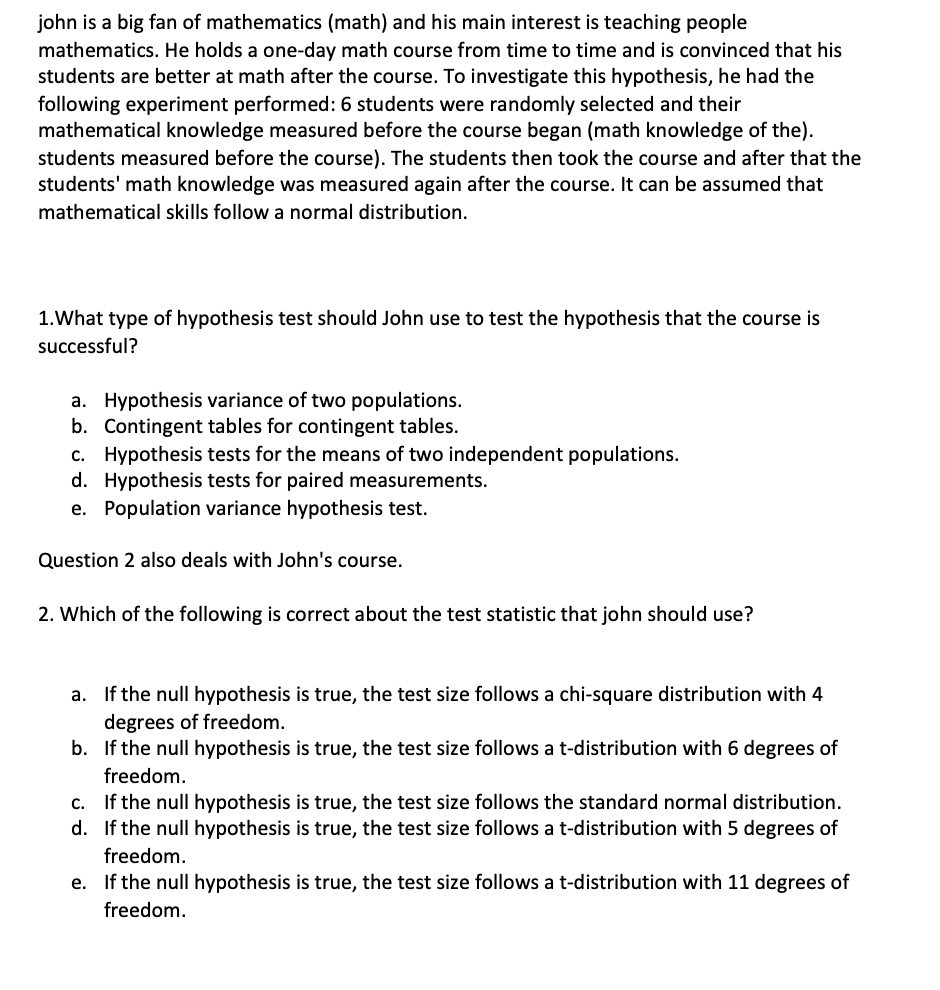mathematics. He holds a one-day math course from time to time and is convinced that his students are better at math after the course. To investigate this hypothesis, he had the following experiment performed: 6 students were randomly selected and their mathematical knowledge measured before the course began (math knowledge of the). students measured before the course). The students then took the course and after that the students' math knowledge was measured again after the course. It can be assumed that mathematical skills follow a normal distribution.
mathematics. He holds a one-day math course from time to time and is convinced that his students are better at math after the course. To investigate this hypothesis, he had the following experiment performed: 6 students were randomly selected and their mathematical knowledge measured before the course began (math knowledge of the). students measured before the course). The students then took the course and after that the students' math knowledge was measured again after the course. It can be assumed that mathematical skills follow a normal distribution.
Algebra & Trigonometry with Analytic Geometry
13th Edition
ISBN:9781133382119
Author:Swokowski
Publisher:Swokowski
Chapter10: Sequences, Series, And Probability
Section10.8: Probability
Problem 29E
Related questions
Topic Video
Question

Transcribed Image Text:john is a big fan of mathematics (math) and his main interest is teaching people
mathematics. He holds a one-day math course from time to time and is convinced that his
students are better at math after the course. To investigate this hypothesis, he had the
following experiment performed:6 students were randomly selected and their
mathematical knowledge measured before the course began (math knowledge of the).
students measured before the course). The students then took the course and after that the
students' math knowledge was measured again after the course. It can be assumed that
mathematical skills follow a normal distribution.
1.What type of hypothesis test should John use to test the hypothesis that the course is
successful?
a. Hypothesis variance of two populations.
b. Contingent tables for contingent tables.
c. Hypothesis tests for the means of two independent populations.
d. Hypothesis tests for paired measurements.
e. Population variance hypothesis test.
Question 2 also deals with John's course.
2. Which of the following is correct about the test statistic that john should use?
a. If the null hypothesis is true, the test size follows a chi-square distribution with 4
degrees of freedom.
b. If the null hypothesis is true, the test size follows a t-distribution with 6 degrees of
freedom.
c. If the null hypothesis is true, the test size follows the standard normal distribution.
d. If the null hypothesis is true, the test size follows a t-distribution with 5 degrees of
freedom.
e. If the null hypothesis is true, the test size follows a t-distribution with 11 degrees of
freedom.
Expert Solution
This question has been solved!
Explore an expertly crafted, step-by-step solution for a thorough understanding of key concepts.
Step by step
Solved in 3 steps

Knowledge Booster
Learn more about
Need a deep-dive on the concept behind this application? Look no further. Learn more about this topic, statistics and related others by exploring similar questions and additional content below.Recommended textbooks for you

Algebra & Trigonometry with Analytic Geometry
Algebra
ISBN:
9781133382119
Author:
Swokowski
Publisher:
Cengage


College Algebra
Algebra
ISBN:
9781305115545
Author:
James Stewart, Lothar Redlin, Saleem Watson
Publisher:
Cengage Learning

Algebra & Trigonometry with Analytic Geometry
Algebra
ISBN:
9781133382119
Author:
Swokowski
Publisher:
Cengage


College Algebra
Algebra
ISBN:
9781305115545
Author:
James Stewart, Lothar Redlin, Saleem Watson
Publisher:
Cengage Learning